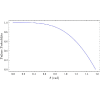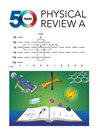离散结果传感器网络。II.多重检测事件和分组检测器
IF 2.9
2区 物理与天体物理
Q2 Physics and Astronomy
引用次数: 0
摘要
对量子传感器网络的研究通常是为了确定它们能在多大程度上准确地确定某个探测器的参数,例如磁场强度。一种更粗粒度的方法是试图简单地确定探测器是否与信号发生了相互作用,以及是哪个探测器。我们在这里研究的就是这种离散结果的量子传感器网络,其离散的意义在于我们正在寻找 "是 "与 "否 "问题的答案。其中一个问题是什么是网络的良好初始状态,尤其是它是否应该纠缠。前面我们研究了只有一个探测器相互作用的情况,这里我们从两个方面扩展了这项研究。首先,我们允许不止一个探测器相互作用;其次,我们研究了探测器分组的效果。当探测器分组时,我们只关心哪一组包含了相互作用的探测器,而不关心组内哪一个探测器发生了相互作用。我们发现,在探测器分组的情况下,纠缠初始状态可能会有所帮助。本文章由计算机程序翻译,如有差异,请以英文原文为准。

Discrete-outcome sensor networks. II. Multiple detection events and grouping detectors
Quantum sensor networks have often been studied in order to determine how accurately they can determine a parameter, such as the strength of a magnetic field, at one of the detectors. A more coarse-grained approach is to try to simply determine whether a detector has interacted with a signal or not, and which detector it was. Such discrete-outcome quantum sensor networks, discrete in the sense that we are seeking answers to yes-no questions, are what we study here. One issue is what is a good initial state for the network, and, in particular, should it be entangled or not. Earlier we looked at the case when only one detector interacted, and here we extend that study in two ways. First, we allow more than one detector to interact, and second, we examine the effect of grouping the detectors. When the detectors are grouped we are only interested in which group contained interacting detectors and not in which individual detectors within a group interacted. We find that in the case of grouping detectors, entangled initial states can be helpful.
求助全文
通过发布文献求助,成功后即可免费获取论文全文。
去求助
来源期刊

Physical Review A
物理-光学
CiteScore
5.40
自引率
24.10%
发文量
0
审稿时长
2.2 months
期刊介绍:
Physical Review A (PRA) publishes important developments in the rapidly evolving areas of atomic, molecular, and optical (AMO) physics, quantum information, and related fundamental concepts.
PRA covers atomic, molecular, and optical physics, foundations of quantum mechanics, and quantum information, including:
-Fundamental concepts
-Quantum information
-Atomic and molecular structure and dynamics; high-precision measurement
-Atomic and molecular collisions and interactions
-Atomic and molecular processes in external fields, including interactions with strong fields and short pulses
-Matter waves and collective properties of cold atoms and molecules
-Quantum optics, physics of lasers, nonlinear optics, and classical optics
 求助内容:
求助内容: 应助结果提醒方式:
应助结果提醒方式:


